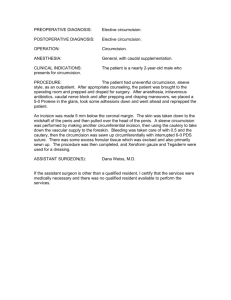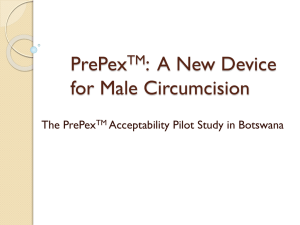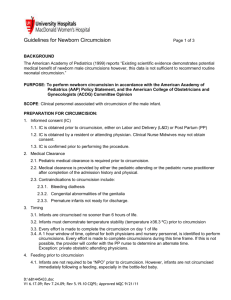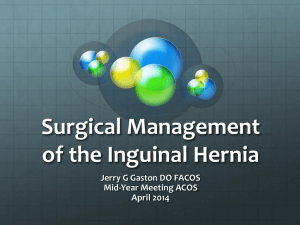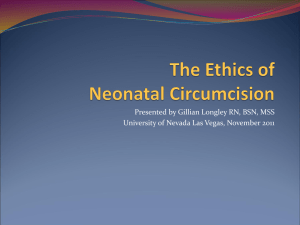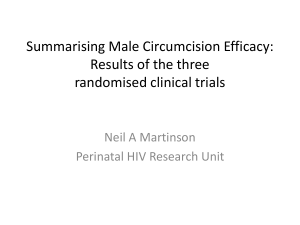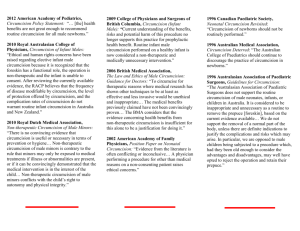BMC Urology Manuscript ID 1441513461289586 Authors responses
advertisement
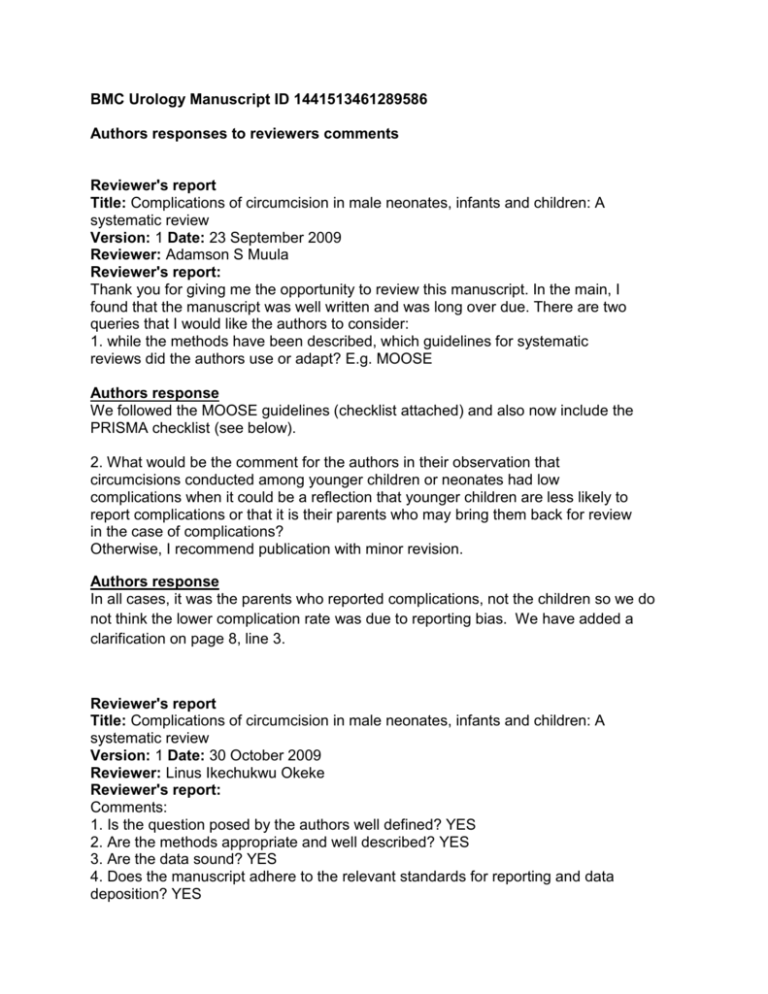
BMC Urology Manuscript ID 1441513461289586 Authors responses to reviewers comments Reviewer's report Title: Complications of circumcision in male neonates, infants and children: A systematic review Version: 1 Date: 23 September 2009 Reviewer: Adamson S Muula Reviewer's report: Thank you for giving me the opportunity to review this manuscript. In the main, I found that the manuscript was well written and was long over due. There are two queries that I would like the authors to consider: 1. while the methods have been described, which guidelines for systematic reviews did the authors use or adapt? E.g. MOOSE Authors response We followed the MOOSE guidelines (checklist attached) and also now include the PRISMA checklist (see below). 2. What would be the comment for the authors in their observation that circumcisions conducted among younger children or neonates had low complications when it could be a reflection that younger children are less likely to report complications or that it is their parents who may bring them back for review in the case of complications? Otherwise, I recommend publication with minor revision. Authors response In all cases, it was the parents who reported complications, not the children so we do not think the lower complication rate was due to reporting bias. We have added a clarification on page 8, line 3. Reviewer's report Title: Complications of circumcision in male neonates, infants and children: A systematic review Version: 1 Date: 30 October 2009 Reviewer: Linus Ikechukwu Okeke Reviewer's report: Comments: 1. Is the question posed by the authors well defined? YES 2. Are the methods appropriate and well described? YES 3. Are the data sound? YES 4. Does the manuscript adhere to the relevant standards for reporting and data deposition? YES 5. Are the discussion and conclusions well balanced and adequately supported by the data? YES 6. Are limitations of the work clearly stated? YES 7. Do the authors clearly acknowledge any work upon which they are building, both published and unpublished? 8. Do the title and abstract accurately convey what has been found? 9. Is the writing acceptable? Level of interest: An article of importance in its field Quality of written English: Acceptable Statistical review: No, the manuscript does not need to be seen by a statistician. Declaration of competing interests: 'I declare that I have no competing interests' Reviewer's report Title: Complications of circumcision in male neonates, infants and children: A systematic review Version: 1 Date: 19 November 2009 Reviewer: Jacob Amir Reviewer's report: The manuscript 'Complications of circumcision in male neonates, infants and children: A systematic review ' deal with early and late compliction of cicumcision. The topic is of great importance and become more relevant due to new data showing that circumcision may reduce the risk to aquire HIV. The review is very comprehancive' however one major complication which is commone after traditional circumcision was not mention: UTI post circumcision, mainly after circumcision done by "Mohel" compare to physicions (Harel et al, Pediatr infect Dis J 2002, 21;879,and Prais , Arch Dis Child 2009, 94:191).This data should be included. Authors response We thank the reviewer for raising this issue. We do mention UTI in the section on traditional circumcision (page 7, second paragraph). We did identify the Harel paper in our systematic review, but not the Prais study which was published after our search date. However both these studies are case-control studies of circumcised infants, comparing circumcision provider among cases (infants with UTI) versus controls (infants without UTI). The rate of UTI in circumcised boys cannot be inferred from this study. However, we agree with the reviewers comment that circumcised boys with UTI were significantly more likely to have been circumcised traditionally and have included in this in the discussion (page 8) as follows: “ Similarly, two case-control studies from Israel have found that UTI are 3-4 times more likely to occur following circumcised by a traditional, rather than medical provider [57, 58]. However, as noted in our review, neonatal circumcision following traditional circumcision in Israel has low complication rates overall [9]. “ Specific remarks; The paper deal with complication in children younger than 12 years, however table 4 mention in the discussion and deals in complication in adolecsent and adults. as the dicussion is very long, I suggest to move the data in Table 4 to the result section. Authors response We thought it interesting to include data on complications in adolescents & adults, but this did not form part of the systematic review and can therefore not be included in the results section. Level of interest: An article of outstanding merit and interest in its field Quality of written English: Acceptable Statistical review: No, the manuscript does not need to be seen by a statistician. Declaration of competing interests: I declare that I have no competing interests EDITORIAL REQUESTS: Please ensure that you have adhered to the guidelines set out by PRISMA. Please see the following link for more information: http://www.prisma-statement.org/ Authors response: Please see below MOOSE checklist (JAMA 2007) Reporting of background: Problem definition, hypothesis statement, description of study outcomes, types of study design and study populations are all reported in the Introduction and Methods Reporting of search strategy: We report an abbreviated search strategy for reasons of space. Full details are given here and could be included if appropriate. Searches were conducted on November 6th 2007 and repeated on February 14th 2009. Additional searches of the Arabic literature were conducted on June 29th, July 18th and July 20th 2008 with follow up searches on August 18th and 22nd 2008. We searched PubMed with the following search terms: "Circumcision, Male"[Mesh] AND "Infant, Newborn"[Mesh] AND ("Africa"[Mesh] OR "Asia"[Mesh]); "complications "[Subheading] OR "Intraoperative Complications"[Mesh] OR "Postoperative Complications"[Mesh]) AND "Circumcision, Male"[Mesh] AND ("Africa"[Mesh] OR "Asia"[Mesh]); ("Child"[Mesh] AND "Circumcision, Male"[Mesh]) AND ("Africa"[Mesh] OR "Asia"[Mesh]); ("Infant, Newborn"[Mesh] OR "Child"[Mesh]) AND ("Circumcision, Male"[Mesh] OR ("Circumcision, Male/adverse effects"[Mesh] OR "Circumcision, Male/complications"[Mesh] OR "Circumcision, Male/contraindications"[Mesh] OR "Circumcision, Male/mortality"[Mesh])); "Circumcision"[Mesh] "Circumcision, Male "[Mesh] AND “Arabic”. In addition, we searched reference lists of relevant papers, including the previous systematic review of complications of male circumcision in Anglophone Africa and books on male circumcision in 10 key academic centres on Middle Eastern Studies in the USA, Australia and Israel. We also searched African Healthline with the following search terms: (CIRCUMCISE OR CIRCUMCISING OR CIRCUMCISIO OR CIRCUMCISION OR CIRCUMCISION-ASSOCIATED OR CIRCUMCISION-INDICATION OR CIRCUMCISION-RELATED OR CIRCUMCISIONS) AND (NEONATAL OR PEDIATRIC OR PEDIATRIC OR PAEDIATRIC OR CHILD); and Medicus for WHO Eastern Mediterranean, IMEMR current contents, Arabic Medical Library, Iran Medex and ALEF with the following search terms: (CIRCUMCISION OR CIRCUMCISING OR CIRCUMCISION-ASSOCIATED. Further searches of LILACS and the SOAS library produced 18 further papers and searches of Hebrew University libraries produced Master and PhD research thesis focused on circumcision of males. A total of 1349 papers were identified through the non-Arabic literature searches. The abstracts of these papers were read and 223 included details on circumcision complications. Full copies of these papers were obtained from the LSHTM, British Library or other University Libraries in the London area. The Arabic literature searches identified a total of 46 relevant books, monographs, thesis and papers َ (circumcision) and ذَكَر We used limited information from the Internet. Using Google to search for ط ُهور ( خِ ت َانmale circumcision) we included sites which contained information by named authors deemed reliable (medical doctors or organizations dealing with family planning, reproductive health etc.). After careful review of 521 sites, only 28 qualified for inclusion. Finally, we used reports from two workshops on neonatal and child circumcision organised by WHO in Abuja Nigeria (March 26-27th 2008)[76], and Accra, Ghana (April 23rd 2008) [77]. We also used a report from a recent survey among Palestinian healthcare providers on circumcision. Reporting of Methods: Relevant details are included under ‘Analysis methods and definitions’. We did not conduct a formal meta-analysis as it was clear a-priori that studies would be very heterogenous for the reasons given in the first paragraph of the discussion Reporting of Results: The tables show details of the number of participants and number with the outcome in each study, plus relevant descriptive information for each study. As we have not undertaken a summary estimate, there are no subgroup analyses. Reporting of Discussion: This includes discussion of potential biases (such as different definitions of complications) and justification for exclusion of the one study on haemophiliacs. Reporting of Conclusions: This includes guidelines for future research. # Checklist item Reported on page # 1 Identify the report as a systematic review, meta-analysis, or both. 1 2 Provide a structured summary including, as applicable: background; objectives; data sources; study eligibility criteria, participants, and interventions; study appraisal and synthesis methods; results; limitations; conclusions and implications of key findings; systematic review registration number. 2 Rationale 3 Describe the rationale for the review in the context of what is already known. 3 Objectives 4 Provide an explicit statement of questions being addressed with reference to participants, interventions, comparisons, outcomes, and study design (PICOS). 3&4 Protocol and registration 5 Indicate if a review protocol exists, if and where it can be accessed (e.g., Web address), and, if available, provide registration information including registration number. No review protocol Eligibility criteria 6 Specify study characteristics (e.g., PICOS, length of follow-up) and report characteristics (e.g., years considered, language, publication status) used as criteria for eligibility, giving rationale. 3 Information sources 7 Describe all information sources (e.g., databases with dates of coverage, contact with study authors to identify additional studies) in the search and date last searched. 3&4 Search 8 Present full electronic search strategy for at least one database, including any limits used, such that it could be repeated. 3 Study selection 9 State the process for selecting studies (i.e., screening, eligibility, included in systematic review, and, if applicable, included in the meta-analysis). 4 Section/topic TITLE Title ABSTRACT Structured summary INTRODUCTION METHODS Data collection process 10 Describe method of data extraction from reports (e.g., piloted forms, independently, in duplicate) and any processes for obtaining and confirming data from investigators. 4 Data items 11 List and define all variables for which data were sought (e.g., PICOS, funding sources) and any assumptions and simplifications made. 4 Risk of bias in individual studies 12 Describe methods used for assessing risk of bias of individual studies (including specification of whether this was done at the study or outcome level), and how this information is to be used in any data synthesis. 4 Summary measures 13 State the principal summary measures (e.g., risk ratio, difference in means). Not applicable Synthesis of results 14 Describe the methods of handling data and combining results of studies, if done, including measures of consistency (e.g., I2) for each meta-analysis. Not applicable Section/topic # Checklist item Reported on page # Risk of bias across studies 15 Specify any assessment of risk of bias that may affect the cumulative evidence (e.g., publication bias, selective reporting within studies). 4, 9 Additional analyses 16 Describe methods of additional analyses (e.g., sensitivity or subgroup analyses, meta-regression), if done, indicating which were pre-specified. Not applicable Study selection 17 Give numbers of studies screened, assessed for eligibility, and included in the review, with reasons for exclusions at each stage, ideally with a flow diagram. 3, 4 Study characteristics 18 For each study, present characteristics for which data were extracted (e.g., study size, PICOS, follow-up period) and provide the citations. Tables 1, 2 and 3 Risk of bias within studies 19 Present data on risk of bias of each study and, if available, any outcome level assessment (see item 12). Not done for each study, but mentioned as appropriate Results of individual studies 20 For all outcomes considered (benefits or harms), present, for each study: (a) simple summary data for each intervention group (b) effect estimates and confidence intervals, ideally with a forest plot. Tables 1-3 Synthesis of results 21 Present results of each meta-analysis done, including confidence intervals and measures of consistency. Not applicable Risk of bias across studies 22 Present results of any assessment of risk of bias across studies (see Item 15). Page 9 Additional analysis 23 Give results of additional analyses, if done (e.g., sensitivity or subgroup analyses, meta-regression [see Item 16]). Not RESULTS applicable DISCUSSION Summary of evidence 24 Summarize the main findings including the strength of evidence for each main outcome; consider their relevance to key groups (e.g., healthcare providers, users, and policy makers). 7-10 Limitations 25 Discuss limitations at study and outcome level (e.g., risk of bias), and at review-level (e.g., incomplete retrieval of identified research, reporting bias). 9 Conclusions 26 Provide a general interpretation of the results in the context of other evidence, and implications for future research. 7,8,10 27 Describe sources of funding for the systematic review and other support (e.g., supply of data); role of funders for the systematic review. 11 FUNDING Funding
